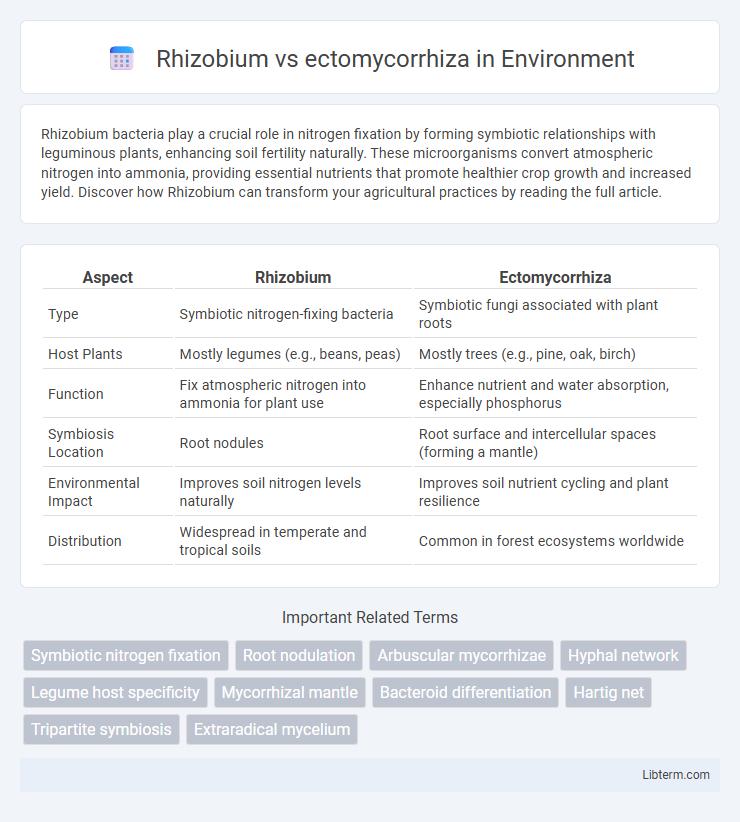Rhizobium bacteria play a crucial role in nitrogen fixation by forming symbiotic relationships with leguminous plants, enhancing soil fertility naturally. These microorganisms convert atmospheric nitrogen into ammonia, providing essential nutrients that promote healthier crop growth and increased yield. Discover how Rhizobium can transform your agricultural practices by reading the full article.
Table of Comparison
| Aspect | Rhizobium | Ectomycorrhiza |
|---|---|---|
| Type | Symbiotic nitrogen-fixing bacteria | Symbiotic fungi associated with plant roots |
| Host Plants | Mostly legumes (e.g., beans, peas) | Mostly trees (e.g., pine, oak, birch) |
| Function | Fix atmospheric nitrogen into ammonia for plant use | Enhance nutrient and water absorption, especially phosphorus |
| Symbiosis Location | Root nodules | Root surface and intercellular spaces (forming a mantle) |
| Environmental Impact | Improves soil nitrogen levels naturally | Improves soil nutrient cycling and plant resilience |
| Distribution | Widespread in temperate and tropical soils | Common in forest ecosystems worldwide |
Introduction to Rhizobium and Ectomycorrhiza
Rhizobium is a genus of nitrogen-fixing bacteria that form symbiotic relationships with leguminous plants, converting atmospheric nitrogen into ammonia to enhance soil fertility. Ectomycorrhiza refers to a type of fungal symbiosis primarily associated with tree roots, where the fungus envelops root tips to improve water and nutrient absorption, particularly phosphorus. Both Rhizobium and ectomycorrhizal fungi play crucial roles in nutrient cycling and plant health within terrestrial ecosystems.
Biological Classification and Taxonomy
Rhizobium belongs to the domain Bacteria, phylum Proteobacteria, and family Rhizobiaceae, characterized as Gram-negative nitrogen-fixing bacteria forming symbiotic relationships with leguminous plants. Ectomycorrhiza fungi are classified within the kingdom Fungi, primarily in the phyla Basidiomycota and Ascomycota, known for forming mutualistic associations with the roots of various tree species. Unlike Rhizobium's bacterial lineage, ectomycorrhizal fungi represent a diverse taxonomic group crucial for nutrient exchange in forest ecosystems.
Mechanisms of Plant Symbiosis
Rhizobium bacteria establish symbiosis with leguminous plants by infecting root hairs and forming specialized structures called nodules, where nitrogen fixation occurs through the enzyme nitrogenase. Ectomycorrhiza fungi form a sheath around plant roots and extend hyphae into the soil and intercellular spaces of the root cortex, enhancing nutrient exchange, particularly phosphorus and trace minerals. Both symbioses rely on molecular signaling pathways, such as Nod factor signaling in Rhizobium and Myc factor signaling in ectomycorrhiza, to initiate mutualistic plant responses and optimize nutrient acquisition.
Host Specificity and Compatibility
Rhizobium bacteria exhibit high host specificity, forming symbiotic nitrogen-fixing nodules primarily with leguminous plants, such as soybean and clover, ensuring compatibility through species-specific signaling molecules like flavonoids and Nod factors. In contrast, ectomycorrhizal fungi demonstrate broad host compatibility, associating with diverse tree species including pines, oaks, and birches, with symbiotic relationships mediated by mutual recognition of root exudates and fungal signaling compounds. The specificity in Rhizobium symbiosis limits its host range, whereas ectomycorrhizae form flexible partnerships that enhance nutrient exchange across various forest ecosystems.
Nitrogen Fixation by Rhizobium
Rhizobium bacteria form symbiotic relationships with leguminous plants, enabling biological nitrogen fixation by converting atmospheric nitrogen (N2) into ammonia (NH3) through nitrogenase enzymes, which directly enriches soil fertility. Ectomycorrhizal fungi, in contrast, primarily enhance nutrient uptake such as phosphorus and nitrogen in organic forms but do not fix atmospheric nitrogen. The presence of Rhizobium significantly reduces the need for synthetic nitrogen fertilizers in agricultural systems by naturally supplementing nitrogen content in the root zone.
Nutrient Uptake via Ectomycorrhiza
Rhizobium primarily enhance nitrogen fixation by forming symbiotic relationships with leguminous plants, converting atmospheric nitrogen into bioavailable forms. In contrast, ectomycorrhiza establish extensive fungal networks in the soil that increase the surface area for nutrient absorption, particularly phosphorus, nitrogen, and essential minerals, enhancing plant nutrient uptake in nutrient-poor soils. This symbiosis significantly improves water retention and nutrient mobilization, promoting plant growth and resilience in various ecosystems.
Morphological Differences
Rhizobium bacteria form rod-shaped or spherical cells that create root nodules primarily on leguminous plants, while ectomycorrhizae consist of fungal hyphae forming dense mantles around plant roots and a Hartig net between root cortical cells. Rhizobium induces intracellular infections within root nodules, whereas ectomycorrhizal fungi remain extracellular, enveloping root tips without penetrating individual cells. Morphologically, Rhizobium nodules are swollen structures hosting nitrogen-fixing bacteria, contrasting with the fungal sheath and extensive external hyphal network characteristic of ectomycorrhizal associations.
Ecological Roles in Soil Ecosystems
Rhizobium forms symbiotic relationships with leguminous plants, fixing atmospheric nitrogen into bioavailable forms that enhance soil fertility and promote plant growth. Ectomycorrhizae establish mutualistic associations with forest trees, extending root systems to improve nutrient and water uptake, while contributing to soil structure and organic matter decomposition. Both organisms play crucial roles in nutrient cycling and ecosystem productivity, with Rhizobium primarily benefiting nitrogen availability and ectomycorrhizae supporting phosphorus acquisition and soil health.
Agricultural and Environmental Applications
Rhizobium bacteria form symbiotic relationships with leguminous plants, fixing atmospheric nitrogen into bioavailable forms, which reduces the need for synthetic fertilizers and enhances soil fertility in sustainable agriculture. Ectomycorrhiza fungi associate primarily with forest trees, improving water and nutrient absorption while boosting plant resistance to pathogens and environmental stress, crucial for reforestation and ecosystem restoration projects. Both microorganisms play significant roles in promoting plant growth, reducing chemical inputs, and maintaining soil health, thereby supporting environmentally friendly agricultural practices and biodiversity conservation.
Comparative Summary: Benefits and Limitations
Rhizobium bacteria form nitrogen-fixing nodules on legume roots, enhancing soil fertility and plant growth through biological nitrogen fixation, but their symbiosis is limited to specific host plants. Ectomycorrhiza fungi create extensive hyphal networks around the roots of many tree species, improving nutrient and water uptake, particularly phosphorus, while aiding in pathogen resistance and soil structure stabilization. However, ectomycorrhizae rely on external organic carbon sources and are less efficient in nitrogen fixation compared to Rhizobium, making their benefits complementary but distinct within terrestrial ecosystems.
Rhizobium Infographic

 libterm.com
libterm.com